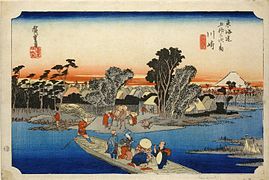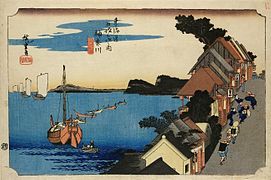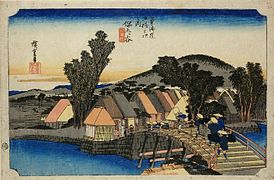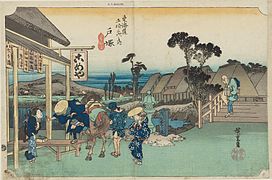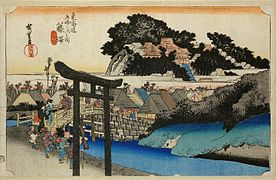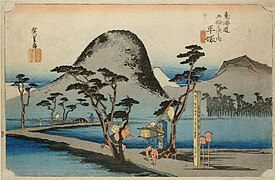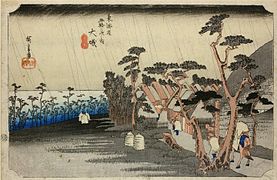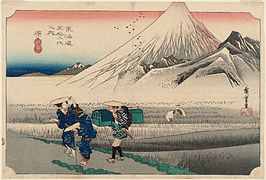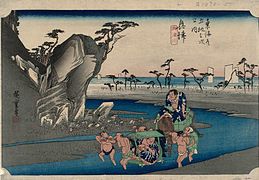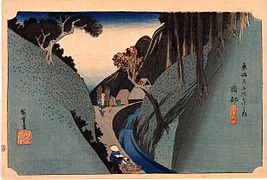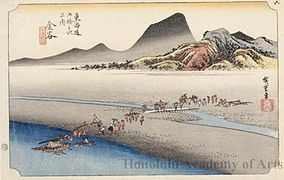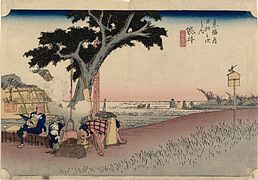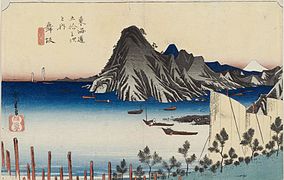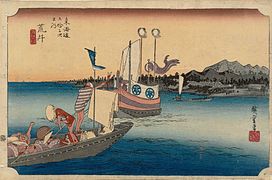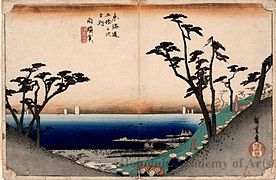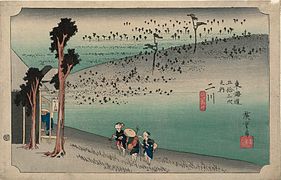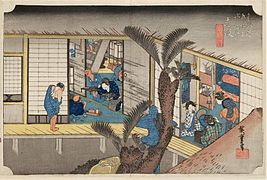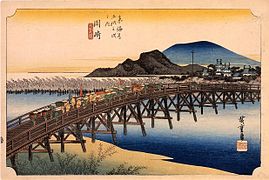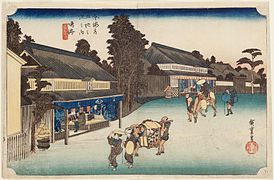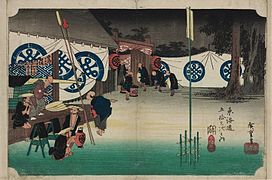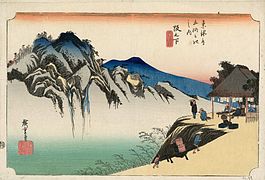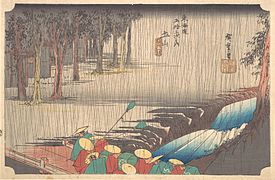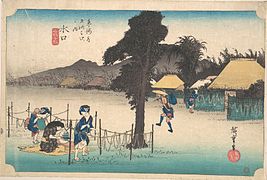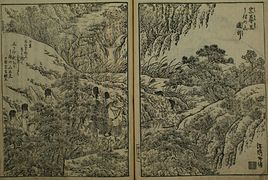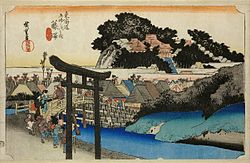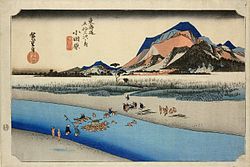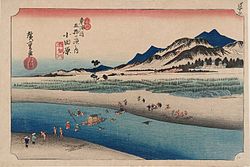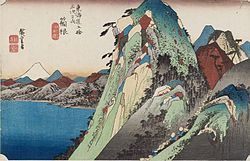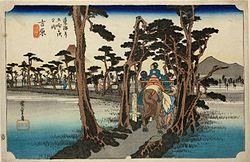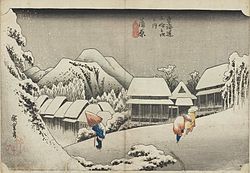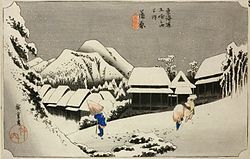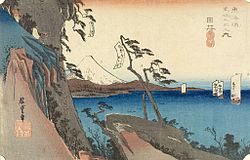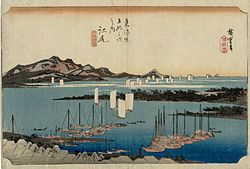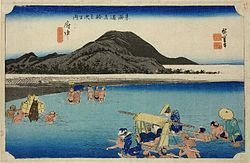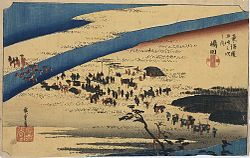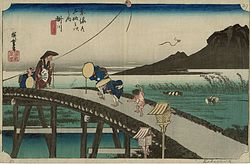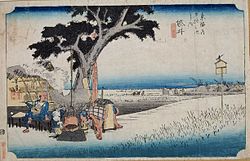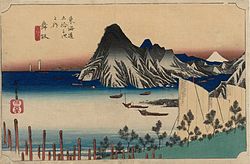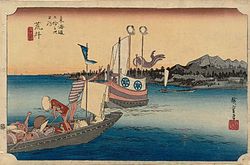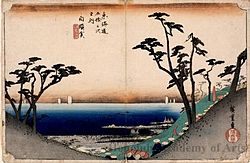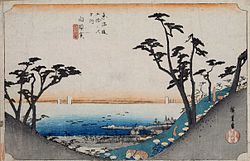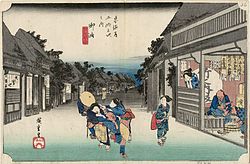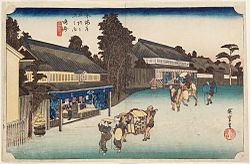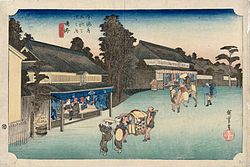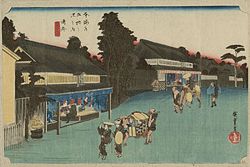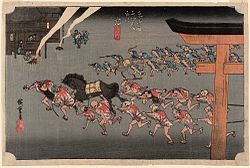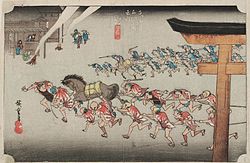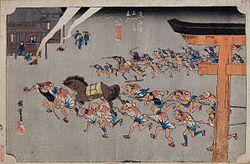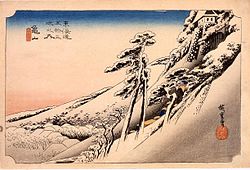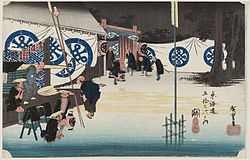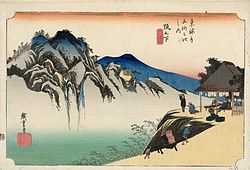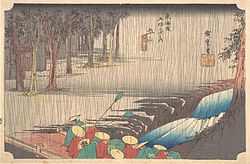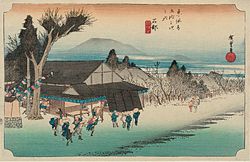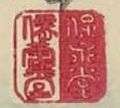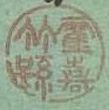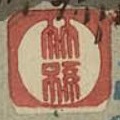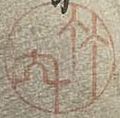The 53 stations of Tōkaidō (Hoeidō edition)
The 53 Stations of Tōkaidō ( Japanese 東海 道 五十 三次 之 内 , Tōkaidō gojūsan tsugi no uchi ), known as The 53 Stations of Tōkaidō ( Hoeidō Edition or Hoeidō Edition ) ( 東海 道 五十 三次 之 内 保 永 堂版 , Tōkaidō gojūsan tsugi no uchi Hoeidō-ban ), is a series of colored woodblock prints designed by the Japanese artist Utagawa Hiroshige in the first half of the 1830s . With the designs for this series, Hiroshige established his reputation as the most important landscape artist in Japan in the field of color woodcut during the last decades of the Edo period . The series is named after the series title and the addition Hoeidō , the registered company name of the publisher Takenouchi Magohachi , who was responsible for the production of most of the prints.
The Hoeidō edition was Hiroshige's first series with the title The 53 Stations of Tōkaidō . By the artist's death in 1858, at least nine series with the same title followed and at least 13 more that had the Tōkaidō and its stations on the subject.
The series comprises 55 prints or, with the later second versions of six prints, a total of 61 sheets. The series was initially published jointly by the two publishers Tsuruya Kiemon and Takenouchi Magohachi. After publishing eleven jointly produced prints, Tsuruya Kiemon resigned as editor for reasons unknown and Takenouchi Magohachi continued the project alone. Before the appearance of the 53 stations of the Tōkaidō , Hiroshige was a largely unknown color woodcut artist. The popularity of the prints and the associated sales success made him the most popular color woodcut artist of his time after Kunisada and Kuniyoshi . The prints of the series experienced numerous reprints and were reprinted until the first printing plates were worn out and had to be replaced by new ones. Many different versions from different publishers already existed in the Meiji period . With the discovery of Japanese art by Western collectors, first from the USA , then also from France , Great Britain and Germany , Hiroshige's prints, and especially the prints of his first series, The 53 Stations of Tōkaidō , gained fame in the West. The series contains some of the artist's best work, such as the stations Mariko, Kambara, Shōno and Kameyama. Along with Hokusai's Great Wave, these prints are among the most famous Japanese woodblock prints outside of Japan.
publication
Hiroshige was a largely unknown artist around 1830, who until then had received only a few commissions for the design of colored woodblock prints. Around 1830 he was commissioned by the publisher Kawaguchiya Shōzō to create a series of large-format prints (that is, prints in ōban format) of views of well-known places in Edo (“Famous Views of the Eastern Capital”, Tōto meisho , 東 都 名 所 ). The series was not an overwhelming success, but has already seen several editions, as the different printing conditions show. The series that Hiroshige as the artist of landscape prints ( fūkeiga , 風景画 ) made known, was the series entitled "The 53 Stations of Tōkaidō" (Tōkaidō gojūsan tsugi no uchi) .
The first prints of this series appeared at the beginning of the 1830s and, like the previous series, were laid out in ōban landscape format. The joint publishers of the first eleven prints were Tsuruya Kiemon and Takenouchi Magohachi . It is no longer possible to clarify who had the idea for this project and who first addressed whom. For Takenouchi Magohachi it was the first project as a publisher, Tsuruya Kiemon was a long-established publishing house. After Tsuruya Kiemon's departure, the reasons for which are unknown, Takenouchi Magohachi continued the project alone.
The prints show scenes around the stations of the Tōkaidō , the most important overland connection from Edo to Kyōto at the time , and its surrounding landscapes as well as the starting point Nihonbashi in Edo and the end station near Kyoto (then also called Keishi ). They were not created in the order of the stations; at most, the order of the drafts was loosely based on the sequence of rest stops.
The prints were very well received by the public and contemporary critics and were published in two volumes in book form by Takenouchi Magohachi after all the individual prints had been published. The title on the cover of the books was "Successive Images of the 53 Stations of Tōkaidō" ( Shinkei Tōkaidō gojūsan eki tsuzukie , 真 景 東海 道 五十 三 駅 続 畫 ). The series title on the prints themselves remained unchanged. However, the prints in the two volumes were folded vertically in the middle, as the books were published in the chuban format (half the ōban format). Many of the prints in the series that have survived today have this center fold as an indication that they originally come from one of these books. Today no complete copies of the first edition of these books are known.
It is estimated that up to 25,000 copies of the first printing plates were made of individual sheets of the series until they were no longer usable. New panels had already been cut in the 19th century in order to produce additional editions. In the 20th century were made more reprints and even in the third millennium this series are still prints sold as woodblock prints and reproductions.
A larger part of the prints was revised after the first publication (changing the color palette, filling in small imperfections, omitting individual contour lines, etc.) so that they are preserved in numerous different variants. Whether these changes are due to considerations of Hiroshige or the publisher or even both can no longer be determined today. It is certain that some of the changes must have been made after the first edition, as individual sheets are extremely rare in the condition of the first edition. A second print version of six stations was made in the second half of the 1830s to replace any lost or damaged printing plates. These new ones are similar to, but not identical to, the previous versions.
The commercial success of the Hiroshige series was closely related to the immense growth in tourist traffic in Japan in the first decades of the 19th century, which had spawned a society that was "addicted to travel and crazy about souvenirs". Immediate predecessors of Hiroshige's series were Katsushika Hokusai's prints of the " 36 Views of Mount Fuji ", which, in terms of their format and image design, representation of people, embedded in the surrounding landscape, were role models for both Hiroshige and other landscape painters of his time.
With his series, however, Hiroshige met the taste of broad sections of the population even more than Hokusai and perfectly implemented the idea of ukiyo as the “cheerful, transitory world” in Japanese landscape printing. What was new about Hiroshige's artistic conception of landscape was not that he made "lively street scenes with busy people from the common people (the) object of artistic discussion". Such genre scenes had previously been drawn by Utagawa Toyohiro and Hokusai, among others . What was new about Hiroshige's pictures was the harmonious integration of the portrayal of people into extensive landscapes. He created lyrical pictures in which the viewer could directly perceive the mood of nature, untroubled by philosophical reflections on nature and man. The prints in the series were imbued with expressive poetic sensitivity . Hiroshige's innovative style and the choice of the horizontal ōban format represented a new focus in the conception of Tōkaidō and presented a new type of landscape printing. Her continued popularity and her influence on other artists are the reasons for Hiroshige's fame.
History of origin
About the creation of the series, Hiroshige III, a student of Hiroshige I and the second husband of his daughter, had casually stated in a newspaper interview in 1894, shortly before his death, that the prints of the series were based on designs that Hiroshige I as a member of a official delegation of the Shogun . In 1832, the delegation had the order to bring a horse as a gift from the Shogun Tokugawa Ienari of Edo to the imperial court in Kyoto. On the way Hiroshige recorded his travel impressions in sketches and after his return to Edo in the 9th month of the year Tenpō 3 (corresponds roughly to September of the year 1832) offered the publisher Takenouchi Magohachi to rework the sketches as templates for a color woodcut series. Iijima Kyōshin first took over this story in his 1894 book "Biographies of the Ukiyo-e Artists of the Utagawa School " ( Utagawa retsuden , 浮世 絵 師 歌 川 列 伝 ). Then it was included in 1930 by Minoru Uchida in his first comprehensive biography of Hiroshige. From then on it was found unchecked in all of the literature that has appeared on Hiroshige. In some cases it was decorated to such an extent that Hiroshige may even have made his sketches on behalf of the Shogun.
In 1970 Suzuki expressed his first doubts about this genesis in his book "Hiroshige" by pointing out the similarity of the Hiroshige prints of the Ishibe and Kanaya stations with the corresponding images in the Tokaidō meisho zue , which appeared in 1797 . Matthi Forrer took up these doubts in 1997 and pointed out the impossibility of the series being completed in 15 months from October 1832 to the end of 1834. Timothy Clark expressed further doubts in 2004, referring to an article published in 1998 by Jun'ichi Okubo in Japan. Clark thinks the story of Hiroshige's participation in an official delegation is a hoax. In 2004, the most comprehensive monograph to date on Hiroshige's first Tōkaidō series by Jūzō Suzuki , Yaeko Kimura and Jun'ichi Okubo , Hiroshige Tōkaidō gojūsantsugi: Hoeidō-ban . The authors showed that 26 of the 55 prints in the series can be traced back to contemporary models by other artists. In addition, a participation of Hiroshige (or Andō as his real name) in a shogunal delegation is not recorded in the files received. Nor is such a trip mentioned in Ukiyo-e ruikō ("Different Thoughts on Ukiyo-e", 浮世 絵 類 考 ), a contemporary who's who of color woodcut artists, which was published while Hiroshige was still alive . Andreas Marks said in connection with his descriptions of Takenouchi Magohachi's publishing activities in 2008 and 2010 that the prints in the series could not be traced back to Hiroshige's own sketches, but to templates from contemporary travel guides . After Marks was able to provide evidence of further books for his book Kunisada's Tōkaidō , From which Hiroshige took suggestions for the design of his prints, he came to the conclusion that the story of the creation of the prints as travel sketches could no longer be maintained.
Dating
In accordance with the traditional genesis in connection with the journey undertaken in the service of the Shogun and the documented return of Hiroshige to Edo in September 1832, the literature gives the year 1832 as the year of origin of the first prints in the series. The date usually given for the completion of the series at the latest by the end of 1833 follows from the foreword by the author Yomo no Takisui (different reading of the name: Yomo Ryūsai), which precedes the first complete edition and begins with the first month of the year Tenpō 5 (around January 1834) is dated.

Matthi Forrer assumes that the date of completion is correctly given in the preface to the complete edition, but expresses doubts whether a series of 55 ōban prints could have been completed within just 15 months between October 1832 and December 1833. No other color woodcut series in ōban format had been so extensive in Japan. The publisher Takenouchi Magohachi was the son of a pawnbroker and did not appear as a publisher prior to the production of the Hiroshige prints. His financial resources or creditworthiness were insufficient to raise the capital required for the printing plates, paper, inks and the remuneration for wood cutters, printers and artists, as well as the cost of a shop to sell the prints in such a short time. Even if a long-established publisher, Tsuruya Kiemon, was involved at the beginning of production, such a short period of 15 months seems extraordinarily short according to Forrer. He concludes from this that the completion of the prints must have taken a longer period of time and thus the first prints must have appeared in 1831 or even as early as 1830.
Jūzō Suzuki also expressed doubts about the date of completion of the series at the end of 1833. According to him, the address of a shop that Takenouchi Magohachi did not open before New Year's Day 1836 was given in the imprint of the complete edition as the address.
Suzuki is also convinced that Kunisada's bijin series Tōkaidō Tōkaidō gojūsan tsugi no uchi , the background of which was based on Hiroshige's series in 43 prints, began in 1833 and was completed in 1835. The fact that 13 of the prints in Kunisada's series have a background that differs from that of the Hiroshige prints is interpreted by Suzuki to mean that Hiroshige had not yet completely designed his series in 1835. Kunisada's publishers, Moriya Jihei and Sanoya Kihei , had urged to complete the series, and therefore backgrounds from the Tokaidō meisho zue and similar books were selected for the last, still missing prints .
Yaeko Kimura was the first to conduct scientific research into the biography of Takenouchi Magohachi, comparing, among other things, the various publisher seals he used. In their opinion, a complete edition of Hiroshige's Tōkaidō could not have been made before New Year's Day 1836.
Since there are no further indications for the exact dating of the prints in the series, the time of their creation can only be narrowed down to roughly the first half of the 1830s.
Image composition
The prints are made in the horizontal (yoko-e) ōban format (approx. 39 × 26 cm). The printed area is separated from the unprinted paper area on all four sides with a thin black line. The corners are rounded inwards so that, together with the approx. 1.5 cm wide edges, the impression of a framed picture is created. In many of the prints that have been preserved, these margins are partially or completely trimmed down to the printing margin, which greatly changes the visual impression of the prints. This is particularly noticeable in the prints from the Hara and Kakegawa stations , in which a picture element “breaks through” the upper frame and in which the lack of this element caused by the trimming destroys the overall composition of the print.
All prints depict travelers on Tōkai Street in some form. They are shown in connection with paths, river landscapes, mountains, lakes and sea panoramas as well as scenes at or in rest stops or temples . Sometimes the travelers can only be seen in tiny groups as staffage in the landscape, sometimes they are a design element of the prints and drawn with individual features. The prints do not follow any program, except that of depicting travelers in different scenarios. The scenes depicted on the prints do not show a specific season, instead the seasonal impressions alternate unsystematically; scenes from all four seasons are shown, with sun, rain or snowfall. The times of day to be recognized in the prints are just as different and unsystematic: Scenes with sunrise and sunset as well as scenes that take place during the day or, in individual cases, at night are shown.
The series title "Tōkaido gojūsan tsuki no uchi" is located in a free space within the composition of the picture. The kanji of the title are written in two or three columns. In each case the title is written in a column (station Okabe) or a line (station Fuchū). To the left of the series title is the name of the respective station, slightly offset, and again to the left of that the subtitle of the respective print; in a few cases the subtitle can be found directly below the station name. Series titles and station names are printed in black; the subtitles are in a red cartridge, which is made in negative or positive printing.
The signature of Hiroshige ( Hiroshige ga , 廣 重 画 ) is printed in black kanji , set apart from the series title, in many cases on the opposite side of the sheet . Below the artist's signature there is a red publisher's seal in various forms. The second version of the print from the Odawara station has an additional red publisher's seal on the right above the series title.
The censorship seal kiwame ( 極 for 'checked') was originally on the lower left edge of the sheets of all prints. At the first three stations, Nihonbashi , Shinagawa and Kawasaki , as well as the Totsuka station , the original joint seal of the publishers Senkakudō and Hoeidō was replaced by a calabash-shaped seal with an integrated censor seal and thus the kiwame seal on the left edge after the revision of the image composition superfluous. On the second versions of the prints from the Kanagawa and Odawara stations, the kiwame seal has also been removed from the left margin and replaced by a publisher's seal with an integrated kiwame seal.
Overview of the prints
The prints themselves are not numbered. They are reproduced in the order that results from the course of Tōkai Street and the rest stops on it. The starting point is the Nihon Bridge in Edo and the end point is the bridge over the Sanjō near Kyōto.
templates
As far as the templates used by Hiroshige for his Tōkaidō series could be identified, a large part is taken from a six-volume travel guide, which was first published in 1797 and had seen numerous new editions in the following years. The travel guide was entitled “Compilation of views of famous places along the Tōkaidō” ( Tōkaidō meisho zue , 東海 道 名 所 図 会 ) by Akisato Ritō and illustrated by Kitao Masayoshi and Takehara Shunsensai as well as numerous other artists. According to Marks, other models come from the books “Wonderful Views of Landscapes” ( Sansui kikan , 山水 竒 観 ; Fuchigami Kyokkō, 1802), “Compilation of views of famous places on the pilgrimage to Ise” ( Ise Sangū meisho zue , 伊 勢 参 宮 名 所 図会 ; Shitomi Kangetsu and Akisato Ritō, 1797), “100 Views of (Mountain) Fuji” ( Hyaku Fuji , 百 富士 ; Kawamura Minsetsu, approx. 1750) and “Collection of Kyōka poems about remarkable landscapes” ( Sansui kikan kyōka shū , 山水 寄 観 狂歌 集 ; Yashima Gakutei, ca.1820). In addition to the Tōkaidō meisho zue and the Ise Sangū meisho zue , Suzuki had already found in 2004 similarities between Hiroshige's prints and images in Jippensha Ikku's “Continuation of the Hizakurige” ( Zoku Hizakurige , 続 膝 栗 毛 ; 1813). The template for the print of the Kakegawa station is a Hokusai print in koban landscape format from an untitled Tōkaidō series that was created around 1805.
The following are some of the illustrations from the Tōkaidō meisho zue that Hiroshige used as the inspiration for his prints. The book showed the stations in the order from Kyoto to Edo, so the stations are described and illustrated in reverse order.
Variants of the prints
All prints included in the following list are originals. In some variants, only the coloring of some parts of the prints was changed. For others, colored areas have been enlarged or reduced. In individual cases only small things were changed, for example by removing the contour line of a mountain. The main printing plates with the black contour lines are identical in all cases. The details such as figures, outlines of objects, the branches of trees, blades of grass or waves of water are the same. In later prints made from recut printing plates, some of the details have been left out or changed and can therefore be distinguished from the original prints on closer inspection.
From six stations (Nihonbashi, Shinagawa, Kawasaki and Kanagawa, Totsuka and Odawara) new versions were made between 1835 and 1840. At first glance, the prints of the new versions are similar to those of the first versions, but on closer inspection they differ greatly from them. The prints of the second version are also considered originals, since they were undoubtedly designed by Hiroshige on behalf of Takenouchi Magohachi. Four of these prints (Nihonbashi, Shinagawa, Kawasaki and Totsuka) replaced versions that had been published jointly by the two publishers Tsuruya Kiemon and Takenouchi Magohachi and which in the second version only bear the Takenouchi Magohachi's seal. The reason for making the second versions is not known. It is possible that the records from the first version were destroyed by accident or disaster.
There are also different printing variants of prints of the second version, for which the same applies as for the variants of the first version: There are minor and major differences, the main printing plates are each identical.
Variants in which the colors have changed due to environmental influences such as light or oxygen are not included in the list. For example, a green becomes a blue through the fading of the yellow part of the color, a purple becomes a brown or an orange shade becomes black through oxidation of the copper it contains.
| No. | Illustration | Title / Subtitle | Publisher's seal, censorship seal |
annotation |
|---|---|---|---|---|
| 01 a) |
Nihonbashi ( 日本 橋 ), "Morning scene" ( asa no kei , 朝 之 景 ) |
round publisher's seal : Tsuruki and Takemago ; kiwame at the bottom left |
The cartridge of the subtitle is printed in red negative (background red, the kanji appear in white). Clouds in the left half of the sky, the summit of Mount Fuji can be seen to the left of the right middle bridge post, the sky at the top is printed in blue, above the silhouette of the city it is orange. |
|
| 01 b) |
as before | as before | Without clouds in the left half of the sky. On the print shown there is a square, red collector's seal below the publisher's seal on the right edge of the picture, which does not belong to the original print. |
|
| 01 c) |
2nd version of changed subtitle: "Beginning of the journey" ( gyōretsu furidashi , 行列 振 出 ) |
pumpkin-shaped publisher's seal: Take ; kiwame is integrated in the publisher's seal | The cartridge of the subtitle is printed in positive red (border and kanji in red). Numerous people populate the foreground, no clouds in the sky, the summit of Mount Fuji has been replaced by a tower with a waving flag, the sky at the top is printed in orange, over the silhouette of the city it is blue, on the left a house roof is missing with a fire tower. The facades on the left and right have been changed. |
|
| 02 a) |
Shinagawa ( 品 川 ), "sunrise" ( hinode , 日 の 出 ) |
square publisher's seal : Senkakudō and Hoeidō ; kiwame at the bottom left |
The cartridge of the subtitle is printed in red negative (background red, the kanji appear in white). Band of clouds in the sky, two archers and two load carriers can be seen on the way to the right, the mast of the boat, which is in the foreground on the pier, only extends approximately to the middle of the boat sailing on the water behind. |
|
| 02 b) |
2nd version with changed subtitle: " Dawn of the Daimyō " ( shokō detachi , 諸侯 出 立 ) |
pumpkin-shaped publisher's seal: Take ; kiwame is integrated in the publisher's seal | The cartridge of the subtitle is printed in positive red (border and kanji in red). In the foreground more people have been added, including two arquebus carriers , another boat can be seen on the left edge of the picture, the mast of the boat on the pier towers over the sail of the boat behind it. |
|
| 02 c) |
as before | without publisher and censor seals | The band of clouds in the upper right half of the image is missing. | |
| 03 a) |
Kawasaki ( 川 崎 ), "The Rokugō Ferry" ( Rokugō watashibune , 六 郷 渡舟 ) |
square publisher's seal : Senkakudō and Hoeidō ; kiwame at the bottom left |
The cartridge of the subtitle is printed in red negative (background red, the kanji appear in white). | |
| 03 b) |
2nd version as before |
pumpkin-shaped publisher's seal: Take ; kiwame is integrated in the publisher's seal | The cartridge of the subtitle is printed in positive red (border and kanji in red). The opposite bank and its background has been extensively redesigned; z. B. Another group of trees in the left half of the picture, a person is missing on the left side of the pier, the bank itself runs parallel, the contours of the roofs have been changed, the Fuji on the right is printed without an outline, in the middle of the print to see a flock of birds in the sky. |
|
| 04 a) |
Kanagawa ( 神奈川 ), "View of the Embankment" ( dai no kei , 臺 之 景 / 台 之 景 ) |
rectangular, horizontal publisher's seal : Hoeidō ; kiwame at the bottom left |
The cartridge of the subtitle is printed in red negative (background red, the kanji appear in white). Clouds in the left part of the sky. |
|
| 04 b) |
as before | as before | A broad black and red stripe can be seen on the horizon over the sea. | |
| 04 c) |
2nd version as before |
pumpkin-shaped publisher's seal: Take ; kiwame is integrated in the publisher's seal | The cartridge of the subtitle is printed in positive red (border and kanji in red). Clouds in the right half of the picture, in front of the ship on the left there is no longer a boat to be seen, the boats to the right of the ship are designed slightly differently, the gables in the row of houses on the right have been redesigned, as are the groups of trees in the area of the houses. |
|
| 05 a) |
Hodogaya ( 程 ヶ 谷, 保 土 ヶ 谷 ), "The Shinmachi Bridge" ( Shinmachi-bashi , 新 町 橋 ) |
square publisher's seal : Senkakudō and Hoeidō ; kiwame at the bottom left |
The cartridge of the subtitle is printed in red negative (background red, the kanji appear in white). | |
| 05 b) |
as before | as before | Less dark blue areas in the water in the foreground, the gray of the background is printed in a lighter tone, so that especially the group of trees in the left half of the picture appears more transparent. | |
| 06 a) |
Totsuka ( 戸 塚 ), "The Intersection in Motomachi" ( Motomachi betsudō , 元町 別 道 ) |
round publisher's seal : Tsuruki and Takemago ; kiwame at the bottom left |
The cartridge of the subtitle is printed in red negative (background red, the kanji appear in white). The blue of the evening sky only reaches the height of the house gable on the right side. |
|
| 06 b) |
as before | as before | The blue of the evening sky almost reaches the height of the tree in the center of the picture and the gray shading is extended to the roofs of the houses on the right to give the impression of twilight. | |
| 06 c) |
2nd version as before |
pumpkin-shaped publisher's seal: Take ; kiwame is integrated in the publisher's seal | The rider mounts the horse. The mountain on the left in the background has been omitted. The roofs of the houses are printed in light gray. The impression of a morning scene is given. | |
| 06 d) |
as before | as before | Differentiated blue clouds are inserted above the left horizon line. | |
| 07 |
Fujisawa ( 藤 沢 ), "The Yūgyō Temple" ( Yugyō-ji , 遊行 寺 ) |
round publisher's seal : Hoeidō ; kiwame at the bottom left |
||
| 08 |
Hiratsuka ( 平 塚 ), "The Road to Nawate" ( Nawate michi , 縄 手 道 ) |
square publisher's seal : Hoeidō and Senkakudō ; kiwame at the bottom left |
||
| 09 |
Ōiso ( 大 磯 ), "tiger rain" ( Tora ga ame , 虎 ヶ 雨 ) |
rectangular, horizontal publisher's seal: Takeuchi han ; kiwame at the bottom left |
The pumpkin-shaped cartridge of the subtitle is printed in red negative (background red, the kanji appear in white). | |
| 10 a) |
Odawara ( 小田原 ), "The Sakama River" ( Sakawagawa , 酒 匂 川 ) |
round publisher's seal in positive and negative printing: Hoeidō ; kiwame at the bottom left |
The cartridge of the subtitle is printed in red negative (background red, the kanji appear in white). | |
| 10 b) |
2nd version as before |
as before; additional, pumpkin-shaped publisher's seal: Take ; kiwame is integrated in the publisher's seal |
The cartridge of the subtitle is printed in positive red (border and kanji in red). The outline of the mountains in the background has been completely changed, three more people in the front left on the bank, plus three supporting frames, the group of people in the river and on the opposite bank has been changed, the group of trees in the middle of the picture has moved further to the left, the river bank on the left The edge of the picture turns to the left, the sky at the top of the picture is tinted red. |
|
| 10 c) |
as before | as before | The outline of the mountains furthest back was changed again (jagged peaks instead of rounded ones), the blue of the sky over the horizon in the left half of the picture extends to the upper edge of the left publisher's seal. | |
| 11 a) |
Hakone ( 箱根 ), "view of the lake" ( kosui (no) zu , 湖水 図 ) |
Publisher's seal as negative print in two separate, square cartridges: Hoei and dō ; kiwame at the bottom left |
||
| 11 b) |
as before | as before | The Fuji on the left side of the picture is printed without a contour line. | |
| 12 a) |
Mishima ( 三島 ), "morning mist" ( asagiri , 朝霧 ) |
round publisher's seal : Hoeidō ; kiwame at the bottom left |
||
| 12 b) |
as before | as before | The figures on the left edge of the picture are shown in full, the fence on the right edge of the picture is higher overall and extends further down to the right. | |
| 13 a) |
Numazu ( 沼 津 ), "Dusk" ( tasogare zu , 黄昏 図 ) |
square publisher's seal : Hoeidō ; kiwame at the bottom left |
||
| 13 b) |
as before | as before | Dark blue areas are added to the river. | |
| 14 a) |
Hara ( 原 ), "Fuji in the morning" ( asa no Fuji , 朝 之 富士 ) |
rectangular, horizontal publisher's seal: Takeuchi ; kiwame at the bottom left |
||
| 14 b) |
as before | as before | In the lower right half of the image, the gray scale has been changed so that a clearer subdivision of the field is created. | |
| 14 c) |
as before | without publisher's seal | The gray gradation is missing at the bottom right. | |
| 15th |
Yoshiwara ( 吉 原 ), "The (mountain) Fuji on the left" ( hidari Fuji , 左 富士 ) |
rectangular, horizontal publisher's seal : Hoeidō ; kiwame at the bottom left |
||
| 16 a) |
Kambara ( 蒲 原 ), "nocturnal snow" ( yoru no yuki , 夜 之 雪 ) |
round publisher's seal: Takeuchi ; kiwame at the bottom left |
The upper part of the sky is printed in black. | |
| 16 b) |
as before | as before | The sky over the village and the mountains is printed in black. | |
| 16 c) |
as before | as before | No black in the sky. | |
| 17 a) |
Yui ( 由 井, 由 比 ), "The summit of (mountain) Satta" ( Satta mine , 薩 (?) 嶺 ) |
square publisher's seal : Hoeidō han ; kiwame at the bottom left |
The main part of the cliff in the foreground, the second cliff from the left and the bank area below Mount Fuji are dark brown. | |
| 17 b) |
as before | as before | The main part of the cliff in the foreground, the second cliff from the left and the lower part of the bank area below Mount Fuji are gray. | |
| 17 c) |
as before | as before | Two leaflets can be seen between the cliff top left and the pine tree in the middle of the picture, the sails of the three boats on the right edge are labeled. | |
| 18 a) |
Okitsu ( 興 津 ), "The Okitsu River" ( Okitsugawa , 興 津 川 ) |
two square, stacked publisher's seals : Tsuruki and Takemago ; kiwame at the bottom left |
||
| 18 b) |
as before | as before | The rocks on the left are printed in red. | |
| 19 a) |
Ejiri ( 江 尻 ), "View of Miho" ( Miho enbō , 三 保 遠望 ) |
calabash-shaped publisher's seal: Hoeidō ; kiwame at the bottom left |
The mountains in the background are printed in gray and brown, the left foreground is a uniform gray. | |
| 19 b) |
as before | as before | The mountains in the background are printed in blue and brown, the roofs of the houses in the left foreground are white, and in the far left corner a black stripe. | |
| 20 a) |
Fuchū ( 府中, 駿 府 ), "The Abe River" ( Abekawa , 安 倍 川 ) |
two square publisher seals : Hoei and dōhan ; kiwame at the bottom left |
The ridges in the background are dark brown with small gray spots. | |
| 20 b) |
as before | as before | The ridges in the background are reddish brown and light gray. | |
| 20 c) |
as before | as before | The ridges in the background are light and dark gray, a dark blue stripe is inserted in the middle of the picture on the right. | |
| 21 a) |
Mariko ( 鞠 子 ), "Famous tea shop" ( meibutsu chamise , 名 物 茶店 ) |
round publisher's seal : Takemago and Tsuruki ; kiwame at the bottom left |
In the first edition, the station name is misspelled: Maruko ( 丸子 ) instead of Mariko ( 鞠 子 ) | |
| 21 b) |
as before | as before | The roof of the house in the foreground is black in the upper part, the fence and the hut to the right of it are also black, in the sky there is a red stripe at the top. | |
| 21 c) |
as before | as before | The roof of the house in the foreground is red-brown, the fence and the hut to the right of it are printed in brown and black, respectively, and in the sky there is a red stripe at the top. | |
| 21 d) |
as before | as before | The roof of the house in the foreground is gray, the fence and the hut to the right of it are printed in brown and black, respectively, there is a red stripe on the upper edge of the sky, the sky is all in pink. | |
| 22 a) |
Okabe ( 岡 部 ), "The Utsu Mountain" ( Utsu no yama , 宇 津 之 山 ) |
square publisher's seal : Hoeidō ; kiwame at the bottom left |
||
| 22 b) |
as before | as before | The left mountain flank is printed in a yellowish shade. The sky over the mountain cut is light blue. | |
| 23 |
Fujieda ( 藤枝 ), "change of porters and horses" ( jinba tsugitate , 人馬 継 立 ) |
square publisher's seal : Tsuruki and Takemago ; kiwame at the bottom left |
||
| 24 a) |
Shimada ( 島 田 ), "The Suruga Bank of the Ōi River" ( Ōigawa sungan , 大 井 川 駿 岸 ) |
square publisher's seal : Hoeidō ; kiwame at the bottom left |
Objects, the hut to the right of the center of the picture and the field to the right below the center are without color, the lower bank of the middle river course is green, the upper one only up to the middle of the print, the upper part of the sandbar in the upper middle is green. | |
| 24 b) |
as before | as before | Objects, hut and field on the right are printed in brown, the lower and upper banks of the middle course of the river are green throughout. | |
| 24 c) |
as before | as before | Objects, hut and field on the right are printed in dark, almost black brown, the right foreground middle to right is in dark gray, there are no more shades of green, the right part of the lower bank of the middle river course is red-brown. | |
| 25 a) |
Kanaya ( 金屋 / 金谷 ), "The distant bank of the Ōi River" ( Ōigawa engan , 大 井 川 遠 岸 ) |
square publisher's seal: Takeuchi ; kiwame at the bottom left |
The sandbank in the foreground is gray, the bridge in the center of the picture is without color, the hills on the right in the background are in yellow, the village to the right of the hill printed in red is printed in gray and therefore barely visible, the mountains on the left in the background are dark - and light gray. | |
| 25 b) |
as before | as before | The sandbank in the foreground is yellowish, the bridge in the middle is also, the hills in the background are in green and the village in it in yellow, the mountains in the background left are black and dark gray. | |
| 26 a) |
Nissaka ( 日 坂 ), "The mountain pass at (mountain) Sayo" ( Sayo no nakayama , 佐 夜 ノ 中山 ) |
square publisher's seal : Tsuruki and Takemago ; kiwame at the bottom left |
The path that runs from the bottom left to the top right is kept in a slightly reddish shade. The mountain flank on the left and the mountain peak in the depression are almost completely blue. Above the mountain in the depression is a clear, red strip of color. | |
| 26 b) |
as before | as before | The path that runs from the bottom left to the top right is kept in a yellowish shade. The mountain flank on the left and the mountain peak in the depression are only blue in the upper parts. The mountain in the depression only has a slightly reddish shimmer to the left and right. | |
| 27 a) |
Kagegawa ( 掛 川 ), "View of Akiba Mountain" ( Akiba-san enbō , 秋葉 山 遠望 ) |
square publisher's seal : Hoeidō ; kiwame at the bottom left |
The mountain in the upper right half of the picture is printed in gray with gray-green areas. Fog is indicated in light gray above the center of the image. The pillars of the bridge are dark gray, the boundaries of the bridge in light gray. | |
| 27 b) |
as before | as before | The mountain in the upper right half of the picture is printed in gray-brown with gray areas. Fog in medium gray is clearly visible to the left above the center of the image. The pillars of the bridge and the bridge boundary are dark brown. | |
| 27 c) |
as before | as before | The mountain in the upper right half of the picture is printed in dark and light gray; there is a brown stripe at the foot of the mountain. A strip of clouds in orange is indicated on the left above the center of the picture. The pillars of the bridge and the bridge boundary are kept in a medium gray tone. | |
| 28 a) |
Fukuroi ( 袋 井 ), "tea shop" ( dejaya no zu , 出 茶屋 ノ 図 ) |
square publisher's seal : Senkakudō and Hoeidō ; kiwame at the bottom left |
The path from the left edge to the right center of the picture is reddish brown. The meadow in the right front half of the picture is gray. Above the horizon line across the center of the picture is a reddish stripe. | |
| 28 b) |
as before | as before | The path from the left edge to the right center of the image is light gray. The meadow in the front right half of the picture is green. A blue sky is indicated above the horizon line across the center of the picture. | |
| 28 c) |
as before | as before | The path from the left edge to the right center of the image is light gray. The meadow in the right front half of the picture also for the larger part. A narrow strip in green is printed from left to right in front. The smoke rising from the fire under the kettle is also structured by black contours above the house roof on the left edge of the picture. | |
| 28 d) |
as before | as before | A wide green stripe stretches across the lower edge of the picture, so that the path and meadow cannot be distinguished. The structure of the smoke rising from the fire is removed again. | |
| 29 a) |
Mitsuke ( 見附 ), "View of the Tenryū River" ( Tenryūgawa zu , 天 竜 川 図 ) |
round publisher's seal : Hoeidō ; kiwame at the bottom left |
||
| 29 b) |
as before | as before | A dark blue stripe has been inserted to the left of the boat in the foreground. The indicated water surface above the sandbank is higher over the entire width of the print. The silhouette of the forest, which extends from the top left to the center of the picture, ends in front of the pole that the seated bosun in the foreground is holding up. | |
| 30 a) |
Hamamatsu ( 浜 松 ), "winter scene" ( fuyugare no zu , 冬 枯 ノ 図 ) |
square publisher's seal : Hoeidō ; kiwame at the bottom left |
||
| 30 b) |
as before | as before | The green area in the foreground has been replaced by a yellow-green area. The area behind the hollow is light gray, as is the smoke from the fire to the left of the tree in the foreground. | |
| 31 a) |
Maisaka ( 舞 阪 ), "View of Imagiri" ( Imagiri shinkei , 今 切 真 景 ) |
square publisher's seal : Hoeidō ; kiwame at the bottom left |
||
| 31 b) |
as before | as before | The trees are missing on the right flank of the mountain in the center of the picture. The summit of Mount Fuji in the right center of the picture is printed without a black contour line. The water surface in the foreground is kept in a stronger color. | |
| 31 c) |
as before | as before | A strong red-brown stripe is inserted above the horizon line from left to right, interrupted by the mountains in the center of the picture. | |
| 32 a) |
Arai ( 荒 井 / 新居 ), "ferry boat" ( watashibune no zu , 渡舟 ノ 図 ) |
square publisher's seal : Takemago ; kiwame at the bottom left |
The clothing of the people sitting in the boat on the left and the person standing on the right in this boat, as well as some of the boat's decors, are printed in purple in the center of the picture. The dark blue in the foreground extends to the right edge of the picture. | |
| 32 b) |
as before | as before | The clothing of the people sitting in the boat on the left and the person standing on the right in this boat, as well as some of the boat's decors, are printed in blue-green in the center of the picture. The dark blue in the foreground extends over three quarters of the foreground. | |
| 32 c) |
as before | as before | The decor of the clothing of the person standing on the left in the boat has been changed. The water surface at the bottom of the picture is printed with a strong blue stripe from left to right. | |
| 32 d) |
as before | as before | The entire water surface is printed in blue. | |
| 33 a) |
Shirasuka ( 白 須 賀 ), "View of Shiomizaka" ( Shiomizaka zu , 汐 見 坂 図 ) |
round publisher's seal : Hoeidō ; kiwame at the bottom left |
The water surface is largely kept in dark blue. | |
| 33 b) |
as before | as before | Half of the water surface is not printed, the rest is light blue, the boats on the water surface are clearly visible. | |
| 34 a) |
Futagawa ( 二 川 ), "The Plateau of the Apes" ( Sarugababa , 猿 ヶ 馬 場 ) |
square publisher's seal : Hoeidō ; kiwame at the bottom left |
||
| 34 b) |
as before | as before | The lower green area is reduced to about half and set off from the foreground by a strong dark gray stripe. | |
| 35 a) |
Yoshida ( 吉田 ), "The Bridge over the Toyo" ( Toyokawabashi , 豊 川 橋 ) |
round publisher's seal : Takemago ; kiwame at the bottom left |
The indicated cloud veil over the horizon is held in a light orange tone. | |
| 35 b) |
as before | as before | The indicated cloud veil over the horizon is held in a medium shade of blue. | |
| 35 c) |
as before | as before | The indicated cloud veil over the horizon is held in a light orange tone. The dark blue areas of the river are reduced by about half at the top and bottom. | |
| 36 a) |
Goyu ( 御 油 ), "women who hold back travelers" ( tabibito tomeru onna , 旅人 留 女 ) |
square publisher's seal: Takeuchi ; kiwame at the bottom left |
There is a wide black stripe at the top. In the middle of the picture there is a large blue field in which the clouds indicated in gray are barely visible. The gray color of the road in the center of the picture extends to the green field in front. | |
| 36 b) |
as before | as before | The black stripe at the top is reduced by half. The blue in the center of the picture has also been reduced so that the clouds indicated in gray are visible. The gray color of the road in the center of the image ends roughly in the middle of the print. | |
| 36 c) |
as before | as before | The road through the town is printed entirely in green. | |
| 37 a) |
Akasaka ( 赤 坂 ), "inn with female service" ( ryosha shōfu no zu , 旅 舎 招 婦 ノ 図 ) |
rectangular publisher's seal : Hoeidō ; kiwame at the bottom left |
||
| 37 b) |
as before | as before | The black bar at the top of the picture is drawn down almost to the left edge of the roof. The gray on the roof on the right is missing. In the lower foreground there is a black bar that almost hides the details of the print at this point. | |
| 38 |
Fujikawa ( 藤 川 ), "Outside a post office" ( bōhana no zu , 棒 鼻 ノ 図 ) |
square publisher's seal : Takemago ; kiwame at the bottom left |
||
| 39 |
Okazaki ( 岡 崎 ), "The Yahagi Bridge" ( Yahagi no hashi , 矢 矧 の 橋 ) |
square publisher's seal : Hoeidō ; kiwame at the bottom left |
||
| 40 a) |
Chiryu ( 地 鯉 鮒 ), "The summer horse market " ( shuka uma ichi , 首 夏馬 市 ) |
square publisher's seal : Hoeidō ; kiwame at the bottom left |
||
| 40 b) |
as before | as before | The whale-shaped hill above the horizon line to the right of the tree has been omitted. | |
| 40 c) |
as before | as before | The yellow-green colored areas are replaced by a light green. The blue band of clouds above the horizon line is reduced to roughly half the height. | |
| 41 a) |
Narumi ( 鳴 海 ), "The famous Arimatsu dyeing" ( meibutsu Arimatsu shibori , 名 物 有 松 絞 ) |
round publisher's seal : Hoeidō han ; kiwame at the bottom left |
There is a narrow blue stripe at the top. The free area in the foreground and in the right half of the picture has a green stripe above and below. | |
| 41 b) |
as before | as before | The blue stripe at the top is roughly doubled in height. The free area in the foreground and in the right half of the picture is printed in light green except for a narrow strip in the middle. | |
| 41 c) |
as before | as before | There is a very narrow blue stripe at the top. The free area in the foreground and in the right half of the picture is printed completely in green, at the top there is a dark green area. | |
| 42 a) |
Miya ( 宮 ), "Festival at the Atsuta Shrine" ( Atsuta shinji , 熱 田 神 事 ) |
calabash-shaped publisher's seal: Hoeidō ; kiwame at the bottom left |
The large free area of the picture is kept in a strong gray tone. | |
| 42 b) |
as before | as before | The large free area of the picture is kept in a light shade of gray. | |
| 42 c) |
as before | as before | The large free area of the picture is kept in a medium gray tone. The black bar at the bottom of the picture has been omitted. | |
| 43 |
Kuwana ( 桑 名 ), "crossing in Shichiri" ( Shichiri watashiguchi , 七里 渡口 ) |
round publisher's seal : Hoeidō ; kiwame at the bottom left |
||
| 44 a) |
Yokkaichi ( 四日 市 ), "The Mie River" ( Miegawa , 三重 川 ) |
elongated oval publisher's seal : Hoeidō ; kiwame at the bottom left |
The clothes of the man on the left on the embankment are yellowish, light green tones. There is a narrow blue stripe over the horizon. | |
| 44 b) |
as before | as before | The clothes of the man on the left on the embankment are printed in green and blue. There is a wide blue stripe over the horizon. | |
| 45 a) |
Ishiyakushi ( 石 薬 師 ), "The Ishiyakuchi Temple" ( Ishiyakushi-ji , 石 薬 師 寺 ) |
rectangular, horizontal publisher's seal : Hoeidō ; kiwame at the bottom left |
The rear ridge is held in a strong blue. The hills in front of it are black in their upper parts. The edges of the path from front right to left are a strong black color. | |
| 45 b) |
as before | as before | Only the hill in the middle is printed in black on its summit, the hills in front of it are green. The dark roadsides are omitted. | |
| 45 c) |
as before | as before | Only the middle summit of the rear ridge is printed. The hill on the right has a gray crest. The field in the foreground is not printed except for a green stripe below. | |
| 46 |
Shōno ( 庄 野 ), "pouring rain" ( hakuu , 白 雨 ) |
square publisher's seal : Hoeidō han ; kiwame at the bottom left |
||
| 47 a) |
Kameyama ( 亀 山 ), "Clear weather after snowfall" ( yukibare , 雪晴 ) |
round publisher's seal : Hoeidō ; kiwame at the bottom left |
||
| 47 b) |
as before | as before | The blue stripe at the top of the picture is reduced to about half. The lower right edge is only kept in a slightly darker gray at the lower right. The black in the delimitation of the path from bottom left to top right has been omitted. | |
| 48 a) |
Seki ( 関 ), "Departure of a daimyō" ( honjin hayadachi , 本 陣 早 立 ) |
rectangular, horizontal publisher's seal : Hoeidō ; kiwame at the bottom left |
The cloth above the gate in the center of the picture and the background of the gate are kept in a red-brown color. | |
| 48 b) |
as before | as before | The green area at the bottom of the picture is reduced to about half. The cloth above the gate in the center of the picture and the background of the gate are kept in a blue-green shade. | |
| 49 a) |
Sakanoshita ( 坂 之下 ), "The Fudesute Mountain" ( Fudesute mine , 筆 捨 嶺 ) |
square publisher's seal : Hoeidō ; kiwame at the bottom left |
The green area on the left in the foreground is extended to a quarter of the height of the picture. The mountain top on the left is printed in black and blue. | |
| 49 b) |
as before | as before | The green area on the left in the foreground is reduced to half its original height. The mountain top on the left is printed in black and gray. The mountain flank itself is kept in a medium gray up to below the waterfall. | |
| 50 |
Tsuchiyama ( 土 山 ), "spring rain " ( haru no ame , 春 之 雨 ) |
square publisher's seal : Hoeidō ; kiwame at the bottom left |
||
| 51 a) |
Minakuchi ( 水口 ), "1000 pumpkins, a specialty" ( meibutsu kampyō , 名 物 千 瓢 ) |
round publisher's seal : Hoeidō han ; kiwame at the bottom left |
The mountains in the background are printed in gray-brown. | |
| 51 b) |
as before | as before | The mountains in the background are printed in blue. | |
| 52 a) |
Ishibe ( 石 部 ), "The Village of Megawa" ( Megawa no sato , 目 川 ノ 里 ) |
round publisher's seal : Hoeidō ; kiwame at the bottom left |
The mountains in the background are printed in dark gray. The indicated fog over the houses and trees in the center of the picture are executed in a narrow strip. In the foreground, the roadside is printed in light gray from the bottom center to the center right to the left. | |
| 52 b) |
as before | as before | The mountains in the background are printed in light gray. The indicated mists over the houses and trees in the center of the picture are extended in height to over the mountain top on the right. In the foreground, only the edge of the road from the bottom center to the center right is printed in gray. | |
| 52 c) |
as before | as before | The mountains in the background are omitted. The indicated fog over the houses and trees in the center of the picture are only executed in red on the right. The foreground and the trees on the right in the picture are dark gray. The roadside is reddish-brown. The roofs of the houses and the treetops in the left half of the picture are green. | |
| 53 a) |
Kusatsu ( 草津 ), "A famous rest house" ( meibutsu tateba , 名 物 立場 ) |
round publisher's seal : Takemago ; kiwame at the bottom left |
A narrow yellow stripe in the foreground, most of the free area is not printed. The roof of the house in the background is printed in blue-gray. The street to the right of the house is light gray. | |
| 53 b) |
as before | as before | The height of the yellow stripe has been doubled. The roof of the house in the background is printed in dark gray, as is the street to the right of the house and the square to the left of the house. | |
| 54 a) |
Ōtsu ( 大 津 ), "The Hashirii Tea House" ( Hashirii chaya , 走 井 茶店 ) |
elongated oval publisher's seal : Takemago ; kiwame at the bottom left |
||
| 54 b) |
as before | as before | In the right background a mountain has been added in bluish printed outlines. | |
| 54 c) |
as before | as before | The outlines of the mountain in the background are added printed in gray. The sky is printed continuously in blue-gray. The roof gables of the houses have a dark gray shade. | |
| 54 d) |
as before | as before | The outline of the mountain in the background is removed again to the left of the trees in the center of the picture. The sky is printed in blue with a narrow strip at the top of the picture. The roof gables of the houses are black, the roofs themselves in dark gray, as are the leaves of the trees and part of the sky above the houses. | |
| 55 |
Keishi ( 京 市 ), "The great bridge over the Sanjō" ( Sanjō ōhashi , 三條 大橋 ) |
rectangular, horizontal publisher's seal : Hoeidō ; kiwame at the bottom left |
Publisher's seal
The two publishers of the series, Tsuruya Kiemon ( 鶴 屋 喜 右衛門 ) and Takenouchi Magohachi ( 竹 内 孫 八 ), used seals with different shapes and different lettering to identify their editorship. For the name designation, both the respective Dōgō ( Bezeichnung 号 ), the designation of the officially registered company name of the publisher, and the Gagō ( 雅号 ), unofficial seal names , which are often, but not always, derived from the official business name ( Yagō , 屋 号 ) , used. Tsuruya Kiemon's dōgō was Senkakudō ( 僊鶴 堂 ), his gagō was Tsuruki ( 鶴 喜 ); the corresponding names of Takenouchi Magohachi were Hoeidō ( 保 永 堂 ) as Dōgō and Take ( 竹 ), Takemago ( 竹 孫 ) and Takeuchi ( 竹 内 ) as Gagō .
The shapes of the seals were square, rectangular, round, oval, or calabash-shaped; they were printed both in positive and negative printing, in some cases also in mixed positive-negative printing for a seal. In cases in which both publishers acted as joint editors, with the exception of the stations Mariko and Hiratsuka, Tsuruya Kiemon is always in the right or upper and thus more prominent position.
The addition han ( 板 ) after the name means "publisher".
Joint seals of Tsuruya Kiemon and Takenouchi Magohachi
Seal of Takenouchi Magohachi alone
Series related to the publication
Series by Hiroshige
In the afterword of the complete edition, the publisher Takenouchi Magohachi announced the appearance of another six series of Hiroshige. Four of them should describe the sights on the roads to Ōyama, Akibayma, Ise and Enoshima . Of these series, only two prints, which are identical in image structure to the prints of the Hoeidō-Tōkaidō, from the series "Tōkaidō - The Way to Enoshima" ( Tōkaidō no uchi - Enoshima michi , 東海 道 之 内 江 ノ 島 路 ) are known: the stations Katase ( 片 瀬 ) and Shichirigahama ( 七里 ヶ 濱 or new 七里 ヶ 浜 ). It is unclear whether further prints were ever made in this context.
The fifth series announced were the prints of the Eight Views of Lake Biwa ( Ōmi Hakkei , 近 江 八景 ). Four of the eight sheets in the series were published by the publishers Takenouchi Magohachi and Yamamotya Heikichi .
The sixth advertised series was "The 69 Stations of Kisokaidō" ( Kisokaidō rokujūkyū-tsugi , 木 曾 街道 六 十九次 ), the scope of which with a total of 70 sheets should even surpass that of the Tōkaidō series. In the image design also identical to that, the stations of the Kisokaidō , the domestic connection from Edo to Kyoto, are shown on the prints of the Kisokaidō series . The first 20 prints in this series were designed by Keisai Eisen and were published by Takenouchi Magohachi in 1835/36. With the participation of the publisher Iseiya Rihei , four more prints designed by Eisen were published around 1836, and only then was Hiroshige the one who designed the remaining 46 prints in the series. At the end of 1836, Takenouchi Magohachi left this project, probably for financial reasons, so that 42 prints were published by Iseya Rihei alone. The success with the public was far less than that of the Tōkaidō series, as the Kisokaidō was less traveled and the market for such prints was saturated.
Series by Kunisada

Probably in 1833 Kunisada began with the designs for a bjin series with the same title "The 53 stations of Tōkaidō" ( Tōkaidō gojūsan tsugi no uchi , 東海 道 五十 三次 之 内 ). The editors of the series in chūban format, comprising 56 prints, were the publishers Sanoya Kihei and Moriya Jihei . This series was the first color woodcut series in Japan that depicted beautiful women and that placed the emphasis on a scenic, scenic depiction of the background. Two thirds of the background on these prints are filled with a landscape, in the lower third women can be seen in different poses on a band of clouds. The first 42 stations and station 44 were closely based on the landscapes of Hiroshige's Tōkaidō, but reworked to portrait format and reduced to the chūban format.
There are three theories about the genesis of the Kunisada series. After the first, Sanoya Kihei was commissioned by Kunisada, as the publisher wanted to share in the commercial success of the motifs with a similar series. The second theory is that Takenouchi Magohachi asked Sanoya Kihei to issue a series of Kunisada prints in order to boost sales of his series' prints. Proponents of the third theory assume that Kunisada himself initiated the production of his series in order to promote the sale of the prints of his friend Hiroshige. Which of the theories is correct cannot be decided. It can be assumed that Hiroshige agreed to the use of his motifs by Kunisada. It can also be assumed that Kunisada's series was very probably completed earlier than that of Hiroshige, since Kunisada used different backgrounds from contemporary travel guides for the last 13 sheets of his series than Hiroshige used in his prints. In view of the fact that many different print variants or print conditions have been preserved, Kunisada's series was at least as successful, if not more successful, than Hiroshige's series, and their sale has favored the sale of Hiroshige's prints.
Kunisada used the motifs from Hiroshige's Tōkaidō series in three other series:
- 1835 in the series "The 53 Stations" produced by Takenouchi Magohachi ( Gojūsan tsugi no uchi , 五十 三次 之 内 ). The pages of the series show actors in roles from the Kabuki play "The 53 Stations during Plum Spring " ( Ume no haru gojūsan tsugi , 梅 初春 五十 三 駅 ), which was performed in the same year . Seven prints in ōban format are known and all seven have a small cartouche image with images from Hiroshige's Tōkaidō.
- In 1836 a fan-leaf series entitled “The 53 Stations” ( Gojūsan tsugi no uchi , 五十 三次 之 内 ) was published on behalf of the publisher Enshūya Matabei . The representations are similar to those from Kunisada's bijin -Tōkaidō series, but reworked to a horizontal format. Three prints of this single Tōkaidō series designed as fan leaves are known.
- 1837/38 in the series produced by Sanoya Kihei entitled "53 couples of actors in fictional roles" ( Mitate yakusha gojūsan tsui no uchi , 見 立 役 者 五十 三 對 の 内 ). The 31 well-known prints of the series in the chūban format show actors in fictional roles and their image design is based on the bijin series, with the landscapes only taking up the upper third of the prints and not as detailed as in the one used as a template Series.
There is also a small-format series of Shunga prints in landscape format with the title “The 53 Stations” ( Gojūsan tsugi no uchi , 五十 三次 ノ 内 ). Eleven prints of this series are known. The landscapes of Hiroshige's prints can be seen in the background and couples engaging in sexual acts on a band of clouds in the foreground. As these prints, like most Shunga, are not signed, they can only be assigned to one artist in terms of style; it is very likely that they were also designed by Kunisada.
Series of Sadanobu I.
In the 1850s a series in the mameban format (112 × 78 mm) appeared in Ōsaka , the prints of which are signed “Sekka ga” (Eng. “Drawn by Sekka”) and which reproduce the prints of the Hiroshige series in small format. The prints in this series do not have a publisher's seal, but, unlike the originals, are numbered on the left margin; the numbers of the prints corresponding to the sequence of the stations on Tōkai Street. "Sekka" ( 雪 化 ) was most likely an alias name of the Sadamasu student Sadanobu I ( 貞 信 ), of whom three other small-format Tōkaidō series are known, which were designed based on the Hiroshige series.
Further Tōkaidō series by Hiroshige
In total, Hiroshige designed more than 700 prints with motifs from Tōkai Street. It was by far his most successful artistic object and made him the most successful artist in this field, which earned him the nickname Tōkaidōshige ( 東海 道 重 ). According to Andreas Marks, at least 22 other Tōkaidō series are known that were designed by Hiroshige or in whose design he was involved. Only a few sheets of some series are known, so it is not certain whether these were ever completely printed. The existence of further series that were planned and / or of which only a very small edition was produced is possible, but not certain, so that as of 2013 no prints have been received or published.
None of these series reached the audience of its time as well known and popular as the first Tōkaidō series. Even among today's collectors of Japanese woodblock prints, only a part of the series is known.
- approx. 1838–42: "Tōkaidō" ( Tōkaidō , 東海 道 ), publisher Yamadaya Shōjirō, 56 prints, yotsugiri (approx. 19 × 13 cm), landscape format
- 1840: "53 stations of Tōkaidō" ( Tōkaidō gojūsan tsugi , 東海 道 五十 三次 ), publisher Sanoya Kihei, 56 prints, chūban (approx. 26 × 19 cm), landscape format
- approx. 1841: “Senjokō-Tōkaido. 53 stations “( Senjokō-Tōkaidō gojūsan tsugi , 千 女 香 東海 道 五十 三次 ), publisher unknown, 56 prints, yotsugiri , portrait format
- 1841/42: "53 stations of Tōkaidō" ( Tōkaidō gojūsan tsugi no uchi , 東海 道 五十 三次 之 内 ), publishers Ezakiya Ichibei and Ezakiya Tatsuzō, 55 prints, aiban (approx. 33 × 23 cm), landscape format
- approx. 1842/43: “Successive drawings of famous views along the Tōkaidō” ( Tōkaidō gojūsan tsugi meisho tsuzuki ga , 東海 道 五十 三次 名 所 続 画 ), publisher Joshūya Kinzō, 55 prints, nijūgiri (dt. '20 parts'), on three ōban (approx. 39 × 26 cm) plus envelope, portrait format
- approx. 1843–46: "Tōkaidō - 53 stations" ( Tōkaidō - gojūsan tsugi no uchi , 東海 道 五十 三次 之 内 ), publisher Aritaya Seimon, 56 prints, yotsugiri , landscape format
- approx. 1843–46: "Collection of views while exploring the 53 stations of Tōkaidō" ( Tōkaidō gojūsan tsugi saiken zue , 東海 道 五十 三次 細 見 図 絵 ), publisher Murataya Tetsu, ōban , portrait format, ten prints known
- approx. 1844–47: “53 stations of Tōkaidō” ( Tōkaidō gojūsan tsugi no uchi , 東海 道 五十 三次 之 内 ), publisher Shimizuya, futatsugiri (approx. 14 × 28 cm), landscape format, three prints known
- 1845: "53 pairs (pictures) of the Tōkaidō" ( Tōkaidō gojusan tsui , 東海道五十三対 ), publisher Ebiya Rinnosuke, Enshūya Matabei, Ibaya Kyubei, Ibaya Senzaburō, Iseya Ichiemon and Kojimaya Jubei, a total of 59 prints plus a design Oban , Portrait format, by Hiroshige 21 prints plus one design, the other prints in the series were designed by Kuniyoshi (30) and Kunisada (8)
- approx. 1847/48: "Tōkaidō - 53 stations" ( Tōkaidō - gojūsan tsugi no uchi , 東海 道 五十 三次 之, ), publisher Tsutaya Kichizō, 54 prints, chūban , landscape format
- End of the 1840s: "Cut-out pictures of the Tōkaidō" ( Tōkaidō harimaze zue , 東海 道 張 交 図 会 ), publisher Ibaya Senzaburō, 12 prints, ōban , portrait format
- 1849: "53 stations of Tōkaidō" ( Tōkaidō gojūsan tsugi , 東海 道 五十 三次 ), publisher Sanoya Kihei, yotsugiri , landscape format, four prints known
- approx. 1850/51: "53 stations of Tōkaidō" ( Tōkaidō gojūsan tsugi , 東海 道 五十 三次 ), publisher Maruya Seijirō, 55 prints, ōban , landscape format
- 1850: "Tōkaidō - 53 stations" ( Tōkaidō - gojūsan tsugi no uchi , 東海 道 五十 三次 之 内 ), publisher Hayashiya Shōgorō, ōban , landscape format, ten prints known
- approx. 1850: “Comfortable pilgrimage along the Tōkaidō to Ise” ( Ise sangū hizakurige Tōkaidōchū , 伊 勢 参 宮 膝 栗 毛東海 道 中 ), publisher Fujiki, ōban , portrait format, five prints known
- 1851/52: "53 stations" ( Gojūsan tsugi , 五十 三次 ), publisher Murataya Ichigorō, 56 prints, chūban , portrait format
- approx. 1851: "53 Pictures from Tōkaidō" ( Tōkaidō gojūsan zue , 東海 道 五十 三 図 絵 ), publisher Fujiokaya Keijirō, ōban , portrait format, 34 prints known
- 1852: "Cut-out pictures of the 53 stations" ( Gojūsan harimaze zue , 五十 三張 交 図 会 ), publisher Izumiya Ichibei, 14 prints, ōban , portrait format
- 1854: "53 stations of Tōkaidō" ( Tōkaidō gojūsan tsugi , 東海 道 五十 三次 ), publisher Yamashiroya Jinbei, 56 prints, yotsugiri , landscape format
- 1855: "Collection of views of famous places along the 53 stations" ( Gojūsan tsugi meisho zue , 五十 三次 名 所 図 絵 ), publisher Tsutaya Kichizō, 55 prints, ōban , portrait format
- 1854–57: "53 stations, painted by two brushes" ( Sōhitsu gojūsan tsugi , 雙筆 五十 三次 ), publisher Maruya Kyūshirō, 55 prints, ōban , portrait format; all prints were designed in collaboration with Kunisada, with the landscape part designed by Hiroshige and the figures in the print by Kunisada
- 1856: "Successive drawings of the 53 stations along the Tōkaidō" ( Tōkaidō gojūsan tsugi tsuzuki ga , 東海 道 五十 三次 続 画 ), publisher Yamaguchiya Tōbei, 15 prints plus cover, ōban , portrait format
literature
- Matthi Forrer: Hiroshige. Prints and Drawings. Prestel, Munich, London, New York 1997, 2nd edition 2001, ISBN 3-7913-2594-9 . (English)
- Setsuko Kuwabara: Hōeidō-ban, Hiroshige: Tōkaidō Gojūsan tsugi. In: Andon 77 , Society for Japanese Arts, November 2004, pp. 50-52. (English)
- Andreas Marks: Kunisada's Tōkaidō. Riddles in Japanese Woodblock Prints. Hotei Publishing, Leiden 2013, ISBN 978-90-04-19146-4 . (English)
- Basil Stewart: A Guide to Japanese Prints and Their Subject Matter. First published 1922. Dover Publications, New York 1979, ISBN 0-486-23809-1 , pp. 78-87. (English)
- Jūzō Suzuki, Yaeko Kimura, Jun'ichi Okubo: 広 重 東海 道 五 拾 三次 保 永 堂 版 (Hiroshige Tōkaidō gojūsantsugi: Hoeidō-ban). Iwanami, Tokyo 2004, ISBN 4-00-008080-6 . (Japanese)
- Chris Uhlenbeck, Marije Jansen: Hiroshige. Shaping the Image of Japan. Hotei Publishing, Leiden 2008, ISBN 978-90-04-17195-4 . (English)
Remarks
- ↑ The first published eleven prints of the joint editorship of the two publishers were: Nihonbashi 01, Shinagawa 02, Kawasaki 03, Hodogaya 05, Totsuka 06, Hiratsuka 08, Okitsu 18, Mariko 21, Fujieda 23, Nissaka 26 and Fukuroi 28.
- ↑ Basil Stewart based his description of the series in 1922 on a copy of the complete edition that was still in existence at the time (Stewart, A Guide to Japanese Prints. P. 78). He mentions the second versions as later variants and therefore these must have been created after the publication of the complete edition.
- ↑ The first pure Tōkaidō series with landscapes came from Hiroshige's teacher Utagawa Toyohiro from the 1800s. Katsuhika Hokusai designed seven series between 1800 and 1810 that had a connection to Tōkaidō and represented genre scenes. Marks, Kunisada's Tōkaidō. P. 46.
- ↑ Forrer dates the beginning of the series to the years 1831/32. Matthi Forrer: Hiroshige. Prints and Drawings. P. 18.
Individual evidence
- ↑ Isaburo Oka: Hiroshige - Japan's Great Landscape Artist . Kodansha, Tokyo 1997, p. 68. (English)
- ↑ Matthi Forrer: Hiroshige. Prints and Drawings. P. 11.
- ↑ a b Andreas Marks: Hiroshige's publishers. In: Uhlenbeck, Jansen: Hiroshige. Shaping the Image of Japan. P. 22.
- ↑ a b c d e Uhlenbeck, Jansen: Hiroshige. Shaping the Image of Japan. P. 44. (English)
- ↑ a b c Isaburo Oka: Hiroshige - Japan's Great Landscape Artist . Kodansha, Tokyo 1997, p. 75. (English)
- ↑ Matthi Forrer: Hiroshige. Prints and Drawings. P. 14.
- ↑ a b c Jūzō Suzuki: Some Observationes on Hiroshige. In: Matthi Forrer: Hiroshige. Prints and Drawings. P. 28. (English)
- ↑ a b Andreas Marks: Japanese Woodblock Prints. Artists, Publishers and Masterworks 1680-1900. North-Clarendon 2010, p. 276. (English)
- ↑ Andreas Marks: Japanese Woodblock Prints. Artists, Publishers and Masterworks 1680-1900. North-Clarendon 2010, p. 190. (English)
- ↑ a b c d e f Kuwabara, Hōeidō-ban, Hiroshige . P. 50.
- ↑ Matthi Forrer: Hiroshige. Prints and Drawings. P. 26.
- ↑ Meiji-period woodcuts of the Hoeidō-Tōkaidō by an unknown publisher on rare posters , accessed on October 28, 2014. (English)
- ↑ Color woodcuts of the Hoeidō-Tōkaidō by the publishers O-Edo Mokuhansha and Yamada Shoin from the 20th century on the website of the Ohmi Gallery , accessed on October 28, 2014. (English)
- ↑ One of several pages with a reproduction of the Hoeidō-Tōkaidō , accessed on October 28, 2014. (English)
- ↑ As an example, Kuwabara cites the first edition of Station Kanaya, of which only two copies are known. Kuwabara, Hōeidō-ban, Hiroshige. P. 50 and p. 52
- ^ Stewart, A Guide to Japanese Prints. P. 79.
- ↑ "The series met exactly the demands of a society which was mad about travel and crazy about souvenirs." Uhlenbeck, Jansen: Hiroshige. Shaping the Image of Japan. P. 11.
- ↑ On the travel bug in Japan during the Edo period, see: Franziska Ehmcke: Reisebieber in the Edo period. In: Franziska Ehmcke, Masako Shōno-Sládek (ed.): Facets of the urban civil culture of Japan from the 17th to 19th centuries. Iudicium, Munich 1994, pp. 55-70.
- ↑ a b Marks, Kunisada's Tōkaidō. P. 46.
- ↑ Quote from Hiroshige biography by Der-Kunstverlag.de Galerie im Stilwerk , accessed on October 31, 2014.
- ↑ Michail Uspenski: Hiroshige - Hundred Views of Edo. Bournemouth, 1997, p. 11 and p. 13
- ↑ a b c d e Matthi Forrer: Hiroshige. Prints and Drawings. P. 17.
- ↑ Uhlenbeck, Jansen: Hiroshige. Shaping the Image of Japan. P. 12.
- ↑ Minoru Uchida: 広 重 (Hiroshige). Iwanami Shoten, Tokyo Shōwa 5 [1930]. (Japanese)
- ^ Richard Lane: Images from the Floating World. Friborg 1978, p. 176. (English)
- ^ Jūzō Suzuki: Utagawa Hiroshige. Nihon Keizai Shimbun, Tokyo 1970. (English)
- ↑ Timothy Clark: Utagawa Hiroshige and the Maruyama Shijō School. In: Amy Reigle Newland (Ed.): The Commercial and Cultural Climate of Japanese Printmaking. Hotei Publishing, Amsterdam 2001, p. 148 f. (English)
- ↑ a b Andreas Marks: Hiroshige's publishers. In: Uhlenbeck, Jansen: Hiroshige. Shaping the Image of Japan. P. 21.
- ↑ a b Marks, Kunisada's Tōkaidō. P. 47.
- ↑ a b c d Kuwabara: Hōeidō-ban, Hiroshige. P. 51.
- ↑ a b c d Marks: Kunisada's Tōkaidō. P. 77.
- ^ Marks, Kunisada's Tōkaidō. Pp. 64, 66 and 74.
- ^ Marks, Kunisada's Tōkaidō. P. 282.
- ^ Stewart, A Guide to Japanese Prints. Pp. 79-82.
- ↑ Matthi Forrer: Hiroshige. Prints and Drawings. P. 18.
- ^ Gordon Friese: Keisai Eisen. Utagawa Hiroshige. The 69 stations of the Kisokaidô. A complete series of Japanese woodblock prints and their print variants. Verlag im Bücherzentrum, Unna 2008, p. 11.
- ^ Gordon Friese: Keisai Eisen. Utagawa Hiroshige. The 69 stations of the Kisokaidô. A complete series of Japanese woodblock prints and their print variants. Verlag im Bücherzentrum, Unna 2008, p. 12 ff.
- ^ Marks, Kunisada's Tōkaidō. P. 76.
- ↑ a b c Marks, Kunisada's Tōkaidō. P. 79.
- ^ Marks, Kunisada's Tōkaidō. P. 85.
- ^ Marks, Kunisada's Tōkaidō. P. 84.
- ^ Marks, Kunisada's Tōkaidō. P. 90 ff.
- ^ Peter Ujlaki, John Fiorillo: Mameban nishiki-e. Diminutive color prints from Kamigata. In: Andon 103 , Society for Japanese Arts, May 2017, pp. 49 and 51. (English)
- ↑ Uhlenbeck, Jansen: Hiroshige. Shaping the Image of Japan. P. 14.
- ^ Marks, Kunisada's Tōkaidō. P. 47 and p. 281 ff.
- ↑ Pictures of the series on "Hiroshige.org" ( memento of October 29, 2014 in the Internet Archive ), accessed on October 9, 2014. (English)
- ↑ Pictures of the series on "Hiroshige.org" ( memento of October 29, 2014 in the Internet Archive ), accessed on October 9, 2014. (English)
- ↑ Pictures of the series on "Hiroshige.org" ( memento of October 29, 2014 in the Internet Archive ), accessed on October 9, 2014. (English)
- ↑ Pictures of the series on "Kunisada Project" , accessed on October 9, 2014. (English)
- ↑ Pictures of the series on "Hiroshige.org" ( memento of October 29, 2014 in the Internet Archive ), accessed on October 9, 2014. (English)
- ↑ Pictures of the series on "Hiroshige.org" ( Memento from April 5, 2015 in the Internet Archive ), accessed on October 9, 2014. (English)
- ↑ Pictures of the series on "Hiroshige.org" ( memento of October 29, 2014 in the Internet Archive ), accessed on October 9, 2014. (English)
- ↑ Pictures of the series on "Hiroshige.org" ( memento of October 29, 2014 in the Internet Archive ), accessed on October 9, 2014. (English)
- ↑ Pictures of the series on "Hiroshige.org" ( memento of October 29, 2014 in the Internet Archive ), accessed on October 9, 2014. (English)
- ↑ Pictures of the series on "Hiroshige.org" ( memento of October 29, 2014 in the Internet Archive ), accessed on October 9, 2014. (English)
- ↑ Pictures of the series on "Kunisada Project" , accessed on October 9, 2014. (English)
Web links
- Website of Hiroshige.org (English)






